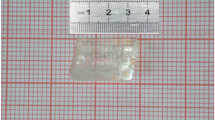Abstract
Doping crystalline materials with chemical dyes impacts their optical, mechanical, and electrical behavior significantly as well. Nontoxic, water-soluble, and highly photosensitive methylene blue (C16H18ClN3S) dye had been doped into the optically active glycine magnesium chloride semi-organic compound. Thus, the vapour diffusion approach was used for nucleation of the methylene blue doped glycine magnesium chloride crystal (MDGMC). The single crystal X-ray diffraction (SCXRD) tool was adopted to evaluate a newly formed MDGMC crystal exhibiting trigonal in structure,\({P}_{31}\) space group lattice parameters such as \(a=b\ne c\) and with \({{V}}=234.93\) Å3. PXRD analyses have confirmed the existence of hybrid compositions with dye and the crystallite dimensions of the chemical substances. The electronic shift was observed at 210 nm cutoff wavelength, exhibiting an optical bandgap about 5.1356 eV, and its vibrations were investigated through spectroscopic instruments such as UV–NIR and FTIR. The outermost layer of the developed crystal material was analyzed using X-rays and scanning electron microscope, along with energy dispersive X-ray analysis (EDAX) for chemical collaboration. The practical and theoretical perspectives of our research were combined with the help of the Gaussian 09W software and its basic set DFT/B3LYP. In connection with this, we computed the molecular electrostatic surface potential (MESP) to evaluate the electrostatic potentials of MDGMC in the range of \(-8.733{\text{e}}^{-2}\;\text{to}\;+8.733{\text{e}}^{-2}\,\text{a.u.}\) the materials interacted in their optimum molecular structure. Reactivity indices and energy surface aptitudes generated HOMO–LUMO via frontiers orbitals of molecules. The Mulliken charge analysis (MCA) was used to approximate atomic values in molecules derived using DFT computations. Experimental and theoretical studies show MDGMC complex compound crystals offer superior optical and electronic activity, making them ideal for photonic equipment design due to their light sensitivity.















Similar content being viewed by others
Data availability
Datasets that are assigned digital object identifiers (DOIs) by a data repository may be cited in the reference list. Data cannot be shared openly but are available on request from authors. Data sets generated during the current study are available from the corresponding author on reasonable request.
References
S. Nandhini, K. Sudhakar, S. Muniyappan, P. Murugakoothan, Systematic discussions on structural, optical, mechanical, electrical and its application to NLO devices of a novel semi-organic single crystal: guanidinium tetrafluoroborate (GFB). Opt. Laser Technol. 105, 249–256 (2018). https://doi.org/10.1016/j.optlastec.2018.03.006
B. Uma, K. SakthiMurugesan, S. Krishnan, R. Jayavel, B. MiltonBoaz, Growth, optical, thermal and dielectric studies of a highly polarisable semiorganic NLO crystal: bis d-phenyl glycinium sulphate monohydrate. Mater. Chem. Phys. 142, 659–666 (2013). https://doi.org/10.1016/j.matchemphys.2013.08.018
S. Goel, N. Sinha, H. Yadav, A.J. Joseph, A. Hussain, B. Kumar, Optical, piezoelectric and mechanical properties of xylenol orange doped ADP single crystals for NLO applications, Arab. J. Chem. 13(1), 146–159 (2020). ISSN 1878-5352. https://doi.org/10.1016/j.arabjc.2017.03.003
F. Pan, M. Shing Wong, C. Bosshard, P. Günter, V. Gramlich, Strong hydrogen bonds as a design element for developing new non-linear optical crystals: co-crystals of merocyanine dyes and phenol derivatives. Adv. Mater. Opt. Electron. 6, 261–266 (1996). https://doi.org/10.1002/(SICI)1099-0712(199609)6:5/6<261::AID-AMO279>3.0.CO;2-K
J. Li, H. Nishikawa, J. Kougo, J. Zhou, S. Dai, W. Tang, X. Zhao, Y. Hisai, M. Huang, S. Aya, Development of ferroelectric nematic fluids with giant-ε dielectricity and nonlinear optical properties. Sci. Adv. 7(17), eabf5047 (2021)
M.L. Finnegan, B.E. Bowler, Scaling properties of glycine-rich sequences in guanidine hydrochloride solutions. Biophys. J. 102(8), 1969–1978 (2012). https://doi.org/10.1016/j.bpj.2012.03.049
B. Gutter, W.T. Speck, H.S. Rosenkranz, A study of the photoinduced mutagenicity of methylene blue. Mutat. Res./Fundam. Mol. Mech. Mutagen. 44(2), 177–181 (1977). https://doi.org/10.1016/0027-5107(77)90075-6
R. Li, J. Chen, T.C. Cesario, X. Wang, J.S. Yuan, P.M. Rentzepis, Synergistic reaction of silver nitrate, silver nanoparticles, and methylene blue against bacteria. Proc. Natl. Acad. Sci. U.S.A. 113(48), 13612–13617 (2016). https://doi.org/10.1073/pnas.1611193113
R. Heiner Schirmer, H. Adler, M. Pickhardt, E. Mandelkow, Lest we forget you—methylene blue …, Neurobiol. Aging 32(12), 2325.e7–2325.e16 (2011). ISSN 0197-4580. https://doi.org/10.1016/j.neurobiolaging.2010.12.012
P.R. Ginimuge, S.D. Jyothi, Methylene blue: revisited. J. Anaesthesiol. Clin. Pharmacol. 26(4), 517–520 (2010)
J.C.Y. Lo, M.A. Darracq, R.F. Clark, A review of methylene blue treatment for cardiovascular collapse. J. Emerg. Med. 46(5), 670–679 (2014). https://doi.org/10.1016/j.jemermed.2013.08.102
M. Oz, D.E. Lorke, M. Hasan, G.A. Petroianu, Cellular and molecular actions of methylene blue in the nervous system. Med. Res. Rev. 31(1), 93–117 (2011). https://doi.org/10.1002/med.20177
D. Kalaitzakis, A. Kouridaki, D. Noutsias, T. Montagnon, G. Vassilikogiannakis, Methylene blue as a photosensitizer and redox agent: synthesis of 5-hydroxy-1H-pyrrol-2(5H)-ones from furans. Angew. Chem. Int. Ed. 54, 6283–6287 (2015). https://doi.org/10.1002/anie.201500744
R. Begum, J. Najeeb, A. Sattar, K. Naseem, A. Irfan, A.G. Al-Sehemi, Z.H. Farooqi, Chemical reduction of methylene blue in the presence of nanocatalysts: a critical review. Rev. Chem. Eng. (2019). https://doi.org/10.1515/revce-2018-0047
S. Canossa, C. Graiff, D. Crocco, G. Predieri, Water structures and packing efficiency in methylene blue cyanometallate salts. Crystals 10(7), 558 (2020). https://doi.org/10.3390/cryst10070558
R. Kumar, S. Sahoo, E. Joanni, R.K. Singh, K. Maegawa, W.K. Tan, G. Kawamura, K.K. Kar, A. Matsuda, Heteroatom doped graphene engineering for energy storage and conversion, Mater. Today 39, 47–65 (2020). ISSN 1369-7021. https://doi.org/10.1016/j.mattod.2020.04.010
R. Kumar, S. Sahoo, E. Joanni, R.K. Singh, W.K. Tan, S.A. Moshkalev, A. Matsuda, K.K. Kar, Heteroatom doping of 2D graphene materials for electromagnetic interference shielding: a review of recent progress. Crit. Rev. Solid State Mater. Sci. 47(4), 570–619 (2022). https://doi.org/10.1080/10408436.2021.1965954
R. Kumar, R.K. Singh, V.S. Tiwari, A. Yadav, R. Savu, A.R. Vaz, S.A. Moshkalev, Enhanced magnetic performance of iron oxide nanoparticles anchored pristine/N-doped multi-walled carbon nanotubes by microwave-assisted approach. J. Alloys Compd. 695, 1793–1801 (2017). https://doi.org/10.1016/j.jallcom.2016.11.010
M.J. Frisch, G.W. Trucks, H.B. Schlegel, G.E. Scuseria, M.A. Robb, J.R. Cheeseman, G. Scalmani, V. Barone, B. Mennucci, G.A. Petersson, Gaussian 09, Revision D.01 (Gaussian Inc, Wallingford, 2010)
K. Kim, K.D. Jordan, Comparison of density functional and MP2 calculations on the water monomer and dimer. J. Phys. Chem. 98(40), 10089–10094 (1994). https://doi.org/10.1021/j100091a024
P.J. Stephens, F.J. Devlin, C.F. Chabalowski, M.J. Frisch, Ab initio calculation of vibrational absorption and circular dichroism spectra using density functional force fields. J. Phys. Chem. 98(45), 11623–11627 (1994). https://doi.org/10.1021/j100096a001
C.J. Cramer, Essentials of Computational Chemistry: Theories and Models, 2nd edn. (Wiley, Hoboken, 2004)
S.A.C. Azhagan, S. Ganesan, Crystal growth, structural, optical, thermal and NLO studies of γ-glycine single crystals. Optik 124(23), 6456–6460 (2013). https://doi.org/10.1016/j.ijleo.2013.05.030
P. Scherrer, Bestimmung der Grösse und der inneren Struktur von Kolloidteilchen mittels Röntgenstrahlen. Nachr. Ges. Wiss. Göttingen 26, 98 (1918)
J.I. Langford, A.J.C. Wilson, Scherrer after sixty years: a survey and some new results in the determination of crystallite size. J. Appl. Crystallogr. 11, 102 (1978)
A. Monshi, M.R. Forought, Modified Scherrer equation to estimate more accurately nano crystallite size using XRD. World J. Nanosci. Eng. 2, 154–160 (2012). https://doi.org/10.4236/wjnse.2012.23020
V. Uvarov, I. Popov, Metrological characterization of X-ray diffraction methods for determination of crystallite size in nano-scale materials. Mater Charact 85, 111 (2013)
G.R. Dillip, G. Bhagavannarayana, P. Raghavaiah, B. Deva Prasad Raju, Effect of magnesium chloride on growth, crystalline perfection, structural, optical, thermal and NLO behavior of -glycine. Cryst. Mater. Chem. Phys. 134, 371–376 (2012). https://doi.org/10.1016/j.matchemphys.2012.03.004
S.Z.A. Ahamed, G.R. Dillip, P. Raghavaiah, K. Mallikarjuna, B. Deva Prasad Raju, Spectroscopic and thermal studies of γ-glycine crystal grown from potassium bromide for optoelectronic applications. Arab. J. Chem. 6(4), 429–433 (2013). https://doi.org/10.1016/j.arabjc.2011.06.006
S.A. Roshan, C. Joseph, M.A. Ittyachen, Mater. Lett.Lett. 49, 299–302 (2001)
V. Venkataramanan, S. Maheswaran, J.N. Sherwood, H.L. Bhat, J. Cryst. Growth 179, 605–610 (1997)
D. Sivavishnu, R. Srineevasan, J. Johnson, Synthesis, growth, optical, band gap energy and mechanical properties of semiorganic nonlinear optical material: 2-aminopyridine potassium dihydrogen orthophosphate lithium chloride (2APKDPL) crystal. Mater. Sci. Energy Technol. 1, 205–214 (2018)
R. Swanepoel, J. Phys. E 16, 1214 (1983)
S. Condurache-Bota et al., Explicit application of Swanepoel’s method for the analysis of Sb2O3 films. J. Sci. Arts 13, 335–340 (2010)
K. Sarojini, H. Krishnan, C.C. Kanakam, S. Muthu, Synthesis, structural, spectroscopic studies, NBO analysis, NLO and HOMO–LUMO of 4-methyl-N-(3-nitrophenyl) benzene sulfonamide with experimental and theoretical approaches. Spectrochim. Acta A 108, 159–170 (2013). https://doi.org/10.1016/j.saa.2013.01.060
M. Habib Rahuman, S. Muthu, B.R. Raajaraman, M. Raja, H. Umamahesvari, Investigations on 2-(4-cyanophenylamino) acetic acid by FT-IR, FT-Raman, NMR and UV–Vis spectroscopy, DFT (NBO, HOMO–LUMO, MEP and Fukui function) and molecular docking studies. Heliyon (2020). https://doi.org/10.1016/j.heliyon.2020.e04976
J. Murray, K. Sen, Theoretical and Computational Chemistry (Elsevier, Amsterdam, 1996), pp.649–660
K. Muthu, V. Meenatchi, M. Rajasekar, A.A. Prasad, K. Meena, R. Agilandeshwari, V. Kanagarajan, S.P. Meenakshisundaram, Combined theoretical and experimental studies on the molecular structure, spectral and Hirshfeld surface studies of NLO tris(thiourea) zinc(II) sulfate crystals. J. Mol. Struct. 1091, 210–221 (2015). https://doi.org/10.1016/j.molstruc.2015.02.085
D. Jacquemin, E.A. Perpète, J. Mol. Struct. THEOCHEM 804(1–3), 31–34 (2007)
R.G. Parr, L.V. Szentpaly, S. Liu, J. Am. Chem. Soc. 121(9), 1922–1924 (1999)
P.K. Chattaraj, S. Giri, J. Phys. Chem. 111(43), 11116–11121 (2007)
R.G. Pearson, Coord. Chem. Rev. 100, 403–425 (1990)
N.M. O’Boyle, A.L. Tenderholt, K.M. Langner, A library for package-independent computational chemistry algorithms. J. Compos. Chem. 29, 839–845 (2008). https://doi.org/10.1002/jcc.20823
M. Snehalatha, C. Ravikumar, I. Hubert Joe, N. Sekar, V.S. Jayakumar, Spectroscopic analysis and DFT calculations of a food additive Carmoisine. Spectrochim. Acta A 72(3), 654–662 (2009). https://doi.org/10.1016/j.saa.2008.11.017
E. Reed, L.A. Curtiss, F. Weinhold, Chem. Rev. 88(6), 899–926 (1988)
E.D. Glendening, J.K. Badenhoop, A.E. Reed, J.E. Carpenter, J.A. Bohmann, C.M. Morales, F. Weinhold, NBO 5.0 (Theoretical Chemistry Institute, University of Wisconsin, Madison, 2001)
M.R. Jagadeesh, H.M. Suresh Kumar, R. Ananda Kumari, Crystal growth and characterization of a semi-organic nonlinear optical (NLO) material: l-phenylalanine cadmium chloride. Can. J. Phys. 93(11), 1296–1301 (2015). https://doi.org/10.1139/cjp-2014-0571
S. Sivakumar, E. Manikandan, Enhanced structural, optical, electrochemical and magnetic behavior on manganese doped tin oxide nanoparticles via chemical precipitation method. J. Mater. Sci. Mater. Electron. 30(8), 7606–7617 (2019). https://doi.org/10.1007/s10854-019-01076-8
S. Sivakumar, E. Manikandan, Novel synthesis of optical photoluminescence properties and supercapacitor application on Zn2+ doping Sn1−xZnxO2 nanoparticles‖. Int. J. Sci. Res. Phys. Appl. Sci. 6, 01–13 (2018). https://doi.org/10.26438/ijsrpas/v6i6.113
M. Meena, R.S. Sundararajan, E. Manikandan, M. Shalini, Diffractional, optical, electrical, NLO, and surface studies of l-asparagine monohydrate lithium sulphate (LAMLS) single crystals. J. Mater. Sci. Mater. Electron. 33(23), 18846–18857 (2022). https://doi.org/10.1007/s10854-022-08734-4
M. Selvapandiyan, J. Arumugam, P. Sundaramoorthi, S. Sudhakar, Influence of MgSO4 doping on the properties of zinc Tris–thiourea sulphate (ZTS) single crystals. J. Alloys Compd. 580, 270–275 (2013)
C. Sekar, R. Parimaladevi, Effect of KCl addition on crystal growth and spectral properties of glycine single crystals. Spectrochim. Acta A 74, 1160–1164 (2009)
Funding
This study was supported by Tamil Nadu State Council for Higher Education (TNSCHE), RC No. 4000/2023 A.
Author information
Authors and Affiliations
Contributions
KT: Writing—Review and editing, Methodology, software and visualizations. KP: Supervision, Validation and funding acquisition. SG: Resources, software and revising.
Corresponding author
Ethics declarations
Conflict of interest
The authors have no relevant financial or non-financial interests to disclose. The authors have no competing interests to declare that are relevant to the content of this article. All authors certify that they have no affiliations with or involvement in any organization or entity with any financial interest or non-financial interest in the subject matter or materials discussed in this manuscript. The authors have no financial or proprietary interests in any material discussed in this article. The authors declare that they have no conflict of interest.
Ethical approval
There is no Human participants and/or Animals involved in the research.
Informed consent
Informed consent was obtained from all individual participants included in the study.
Additional information
Publisher's Note
Springer Nature remains neutral with regard to jurisdictional claims in published maps and institutional affiliations.
Rights and permissions
Springer Nature or its licensor (e.g. a society or other partner) holds exclusive rights to this article under a publishing agreement with the author(s) or other rightsholder(s); author self-archiving of the accepted manuscript version of this article is solely governed by the terms of such publishing agreement and applicable law.
About this article
Cite this article
Kamatchi, T., Kumaresan, P. & Suresh, G. Characterizing the molecules of methylene blue doped glycine magnesium chloride (MDGMC) semi-organic crystal in virtue of quantum computational and analytical approach for photonics. J Mater Sci: Mater Electron 35, 213 (2024). https://doi.org/10.1007/s10854-024-11946-5
Received:
Accepted:
Published:
DOI: https://doi.org/10.1007/s10854-024-11946-5




